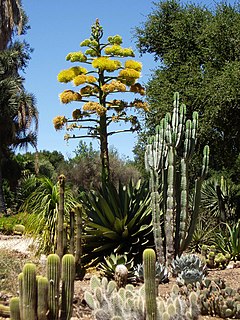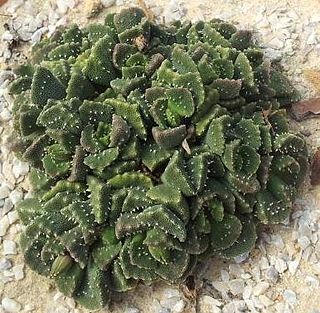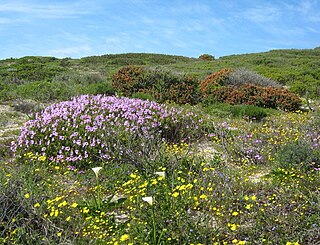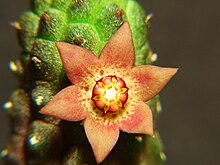
A cactus is a member of the plant family Cactaceae, a family comprising about 127 genera with some 1750 known species of the order Caryophyllales. The word "cactus" derives, through Latin, from the Ancient Greek κάκτος, kaktos, a name originally used by Theophrastus for a spiny plant whose identity is now not certain. Cacti occur in a wide range of shapes and sizes. Most cacti live in habitats subject to at least some drought. Many live in extremely dry environments, even being found in the Atacama Desert, one of the driest places on earth. Cacti show many adaptations to conserve water. Almost all cacti are succulents, meaning they have thickened, fleshy parts adapted to store water. Unlike many other succulents, the stem is the only part of most cacti where this vital process takes place. Most species of cacti have lost true leaves, retaining only spines, which are highly modified leaves. As well as defending against herbivores, spines help prevent water loss by reducing air flow close to the cactus and providing some shade. In the absence of leaves, enlarged stems carry out photosynthesis. Cacti are native to the Americas, ranging from Patagonia in the south to parts of western Canada in the north—except for Rhipsalis baccifera, which also grows in Africa and Sri Lanka.

Euphorbia is a very large and diverse genus of flowering plants, commonly called spurge, in the spurge family (Euphorbiaceae). "Euphorbia" is sometimes used in ordinary English to collectively refer to all members of Euphorbiaceae, not just to members of the genus. Some euphorbias are commercially widely available, such as poinsettias at Christmas. Some are commonly cultivated as ornamentals, or collected and highly valued for the aesthetic appearance of their unique floral structures, such as the crown of thorns plant. Euphorbias from the deserts of Southern Africa and Madagascar have evolved physical characteristics and forms similar to cacti of North and South America, so they are often incorrectly referred to as cacti. Some are used as ornamentals in landscaping, because of beautiful or striking overall forms, and drought and heat tolerance.

According to APG II, the Asclepiadaceae, commonly known as milkweed family, is a former plant family now treated as a subfamily in the Apocynaceae.

The Aizoaceae, or fig-marigold family, is a large family of dicotyledonous flowering plants containing 135 genera and about 1800 species. They are commonly known as ice plants or carpet weeds. They are often called vygies in South Africa and New Zealand. Highly succulent species that resemble stones are sometimes called mesembs.

Crassulacean acid metabolism, also known as CAM photosynthesis, is a carbon fixation pathway that evolved in some plants as an adaptation to arid conditions that allows a plant to photosynthesize during the day, but only exchange gases at night. In a plant using full CAM, the stomata in the leaves remain shut during the day to reduce evapotranspiration, but they open at night to collect carbon dioxide and allow it to diffuse into the mesophyll cells. The CO
2 is stored as the four-carbon acid malic acid in vacuoles at night, and then in the daytime, the malate is transported to chloroplasts where it is converted back to CO
2, which is then used during photosynthesis. The pre-collected CO
2 is concentrated around the enzyme RuBisCO, increasing photosynthetic efficiency. This mechanism of acid metabolism was first discovered in plants of the family Crassulaceae.

The genera of plants within the tribe Stapelieae are all to varying degrees stem succulents. Many of the species resemble cacti, though are not closely related, as an example of convergent evolution. The stems are often angular, mostly four-angled in cross-section, but in some species there are six or more, with some species of Hoodia having more than thirty angles. In size they vary from less than 2.5 cm/1" in length to over 2 m/6" tall. The leaves are in most species reduced to rudiments, sometimes hardened and thorn-like, arranged on bumps or tubercles on the angles. Some species, however, still have recognisable leaves, most notably the Indian species Frerea indica, and some members of Tridentea. Stapeliads are most abundant in warm, dry climates. In Africa, there are two separate regions where Stapeliads have most diversified: northeast Africa, and Southern Africa. Several species are endemic to the small island of Socotra off the Horn of Africa. The Arabian Peninsula, and most specifically the country of Yemen, contain another concentration of species. Several more are found in the drier parts of Pakistan, Afghanistan, India, Nepal, and Myanmar. A single species, Caralluma europea is found in Europe, in the very southern part of the Iberian peninsula. Stapeliads are often regarded as a climax group within the family because of their often structurally complex flowers. Certain aspects of these reproductive parts mirror the pollination systems in the Orchid family and represent a case of parallel evolution though both groups are quite unrelated and have developed similar, though not identical means to achieve the ultimate goal of pollination and therefore reproduction. Most stapeliads use flies as pollinators, that are attracted to odours resembling dung or rotting meat, emanating from the flowers. Many of the flowers also bear some physical resemblance to rotting animal carcasses, leading to their popular name of Carrion Flowers. However, not all stapeliads smell bad, or attract flies. Some species use beetles, bees, wasps, butterflies or moths as pollinators. Stapeliad flowers range in size from mere millimetres in species of Echidnopsis and Pseudolithos to those of Stapelia gigantea that can reach 40 cm/16" in diameter, and are some the largest of flowers to be found on any species of succulent.
A storage organ is a part of a plant specifically modified for storage of energy (generally in the form of carbohydrates) or water. Storage organs often grow underground, where they are better protected from attack by herbivores. Plants that have an underground storage organ are called geophytes in the Raunkiær plant life-form classification system. Storage organs often, but not always, act as perennating organs which enable plants to survive adverse conditions.

A plant cutting is a piece of a plant that is used in horticulture for vegetative (asexual) propagation. A piece of the stem or root of the source plant is placed in a suitable medium such as moist soil. If the conditions are suitable, the plant piece will begin to grow as a new plant independent of the parent, a process known as striking. A stem cutting produces new roots, and a root cutting produces new stems. Some plants can be grown from leaf pieces, called leaf cuttings, which produce both stems and roots. The scions used in grafting are also called cuttings.

The Arizona Cactus Garden, or, officially, Arizona Garden, also known as the Cactus Garden, is a botanical garden specializing in cactus and succulents. It is located on the campus of Stanford University, Stanford, California, USA, and open to the public daily without charge.

Aloinopsis is a genus of ice plants from South Africa.

Nicholas Edward Brown was an English plant taxonomist and authority on succulents. He was also an authority on several families of plants, including Asclepiadaceae, Aizoaceae, Labiatae and Cape plants.
Live Forever or Liveforever may refer to:

The Succulent Karoo is a ecoregion defined by the World Wide Fund for Nature to include regions of desert in South Africa and Namibia,and a biodiversity hotspot. The geographic area chosen by the WWF for what they call 'Succulent Karoo' does not correspond to the actual Karoo.

In botany, succulent plants, also known as succulents, are plants with parts that are thickened, fleshy, and engorged, usually to retain water in arid climates or soil conditions. It is a characteristic that is not used scientifically for the definition of most families and genera of plants because it often can be used as an accurate characteristic only at the single species level. The word succulent comes from the Latin word sucus, meaning 'juice', or 'sap'. Succulent plants may store water in various structures, such as leaves and stems. Some definitions also include roots, thus geophytes that survive unfavorable periods by dying back to underground storage organs may be regarded as succulents. In horticultural use, the term succulent is sometimes used in a way that excludes plants that botanists would regard as succulents, such as cacti. Succulents are often grown as ornamental plants because of their striking and unusual appearance, as well as their ability to thrive with relatively minimal care.

Namaqua National Park is a South African national park situated approximately 495 km north of Cape Town and 22 km northwest of Kamieskroon. It has an area of more than 1300 km2. The park is part of Namaqualand, an area covering 55,000 km2 located within the semi-desert Succulent Karoo biome. This biome is a biodiversity hotspot with the largest concentration of succulent plants in the world. The park also has an arid environment with succulent plants. The park was created to protect its flowers. During the spring, wildflowers bloom there in a spectacular fashion. The park's main tourist attraction is this abundant spring bloom of brightly coloured wildflowers.

The Albany thickets is an ecoregion of dense woodland in southern South Africa, which is concentrated around the Albany region of the Eastern Cape.

Cape Flats Dune Strandveld is an endangered vegetation type. This is a unique type of Cape Strandveld that is endemic to the coastal areas around Cape Town, including the Cape Flats.

The North-West University Botanical Garden on the Potchefstroom Campus of the North-West University (NWU) is the only botanical garden in the North West Province of South Africa. The Garden spans just under three hectares and is open to the public.

The Stellenbosch University Botanical Garden located in the historical center of Stellenbosch is the oldest university botanical garden in South Africa. The Garden is relatively small and houses an enormous diversity of plants, both indigenous to South Africa and introduced species. It is open to the public.

Peter René Oscar Bally was a Swiss botanical illustrator, botanist and taxonomist. The standard author abbreviation P.R.O.Bally is used to indicate this person as the author when citing a botanical name.


















